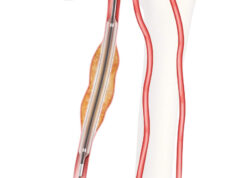Two young men went camping in the wilderness. One of them went off to gather firewood. He returned an hour later, staggering, badly battered, very bloody and with his clothes in tatters. His friend asked what happened. “I ran into a blacksnake” was the reply. “Everyone knows that blacksnakes are harmless,” his friend retorted. “They are not so harmless if they make you jump off a cliff.”
How does this story apply to vascular surgery and vascular disease patients? It is very relevant to the management of asymptomatic carotid stenosis, small aneurysms, or nondisabling intermittent claudication — all conditions that are not dangerous and in most cases cause no serious harm.
Let’s look first at asymptomatic carotid stenosis. A healthy, totally asymptomatic 58-year-old man with no cardiovascular risk factors undergoes a carotid screening exam by a commercial mobile laboratory service. He is told that he has a moderate carotid stenosis and a proper carotid duplex is recommended. This is obtained in the office of a “vascular specialist,” and it shows that the patient has a “50%-60% narrowing of his left internal carotid artery.” The vascular specialist advises him to have a “minimally invasive” carotid stent placed. This is performed in the local hospital by the vascular specialist. The patient has a “minor stroke” with near complete recovery within 2 months except for some persistent difficulty with fine movements of his right hand and some difficulty finding words. Although the man is able to keep his job, he is not as skilled at it as he was.
This patient is a victim of the blacksnake phenomenon. Although his carotid stenosis had more than a 95% chance of causing him no future harm, he suffered a somewhat disabling stroke that he would not have had if he had not undergone the screening exam. In other words the detection of the lesion and its unnecessary invasive treatment lead to a problem that otherwise would not have occurred.
Another example of a potential blacksnake phenomenon occurred in a 74-year-old retired hand surgeon with a 4.1-cm (diameter) abdominal aortic aneurysm. In 2004 this patient saw a vascular surgeon who was then chief of service at a major university center that was just beginning to perform EVAR. The patient had favorable anatomy for EVAR, and the vascular surgeon apparently wished to increase his limited experience with the procedure. The patient was advised to have the EVAR procedure “as soon as possible.” He sought a second opinion and was advised to have his aneurysm observed periodically. Ten years later the patient remains well, and the aneurysm still has a diameter of 4.1 cm. If this patient had had an urgent EVAR in 2004 and had had any complication, it would have been a clear example of the blacksnake phenomenon. The fact-based second opinion and the patient’s willingness to follow the appropriately conservative option spared him any exposure to the risk of treating a largely harmless condition. Harm from the blacksnake phenomenon was avoided.
Another patient who was spared exposure to the blacksnake phenomenon was a 58-year-old hypertensive hyperlipidemic smoker who had had a coronary artery bypass and who sought a second opinion for treatment of two block left calf claudication. The patient had had three endovascular procedures by a “vascular specialist” for a long superficial femoral artery occlusion which was causing the same symptom. All three interventions had failed, and a bypass had been suggested by the same specialist. The second opinion work-up revealed that the patient shockingly had not been placed on statins, had not been advised to stop smoking, and was not being treated for his hypertension by his intervening vascular specialist or the cardiologist who had referred the patient for his three interventions. Nor had he been told that his uncorrected femoral artery occlusion posed little risk to his limb or his life. The vascular surgeon providing the second opinion advised no treatment for the femoral occlusion, but placed the patient on statins, anti-hypertensives, and other medical measures. Had the patient undergone a fourth intervention or a bypass for the femoral occlusion, his risks would have been substantial. Avoiding these risks spared the patient the likelihood of being victimized by the blacksnake phenomenon.
All these cases are real. Yet all are examples of an actual or potential blacksnake phenomenon which can and does occur commonly in our system of vascular care. These cases emphasize that patients can be harmed by the blacksnake phenomenon, which results from the benign natural history of many vascular lesions which are better left uncorrected. Fixing such lesions simply because they exist and are detected causes more harm than benefit to patients. Many self-appointed vascular specialists are not fully aware of this benign natural history. Others, it seems, choose to ignore it, perhaps for bad motives. However, it behooves all specialists that treat non-coronary vascular disease to be aware of the natural history of various lesions and conditions, so that they do not treat patients with them unnecessarily or for the wrong reasons.
Moreover, they must be aware of and utilize optimal medical treatments for these lesions and conditions. In that way patients can be spared exposure to the blacksnake phenomenon, and real vascular specialists can provide the best overall care for their patients.
Dr. Veith is Professor of Surgery at New York University Medical Center and the Cleveland Clinic. He is an associate medical editor for Vascular Specialist.
The ideas and opinions expressed in Vascular Specialist do not necessarily reflect those of the Society or Publisher.













